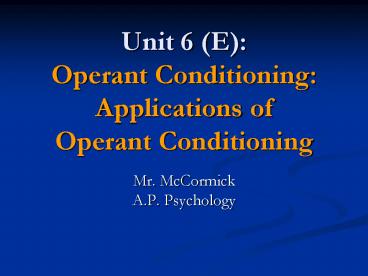Unit 6 (E): Operant Conditioning: Applications of Operant Conditioning - PowerPoint PPT Presentation
1 / 8
Title:
Unit 6 (E): Operant Conditioning: Applications of Operant Conditioning
Description:
Unit 6 (E): Operant Conditioning: Applications of Operant Conditioning Mr. McCormick A.P. Psychology Do-Now (Questionnaire/In Journal) Answer the questions on Hand ... – PowerPoint PPT presentation
Number of Views:258
Avg rating:3.0/5.0
Title: Unit 6 (E): Operant Conditioning: Applications of Operant Conditioning
1
Unit 6 (E)Operant ConditioningApplications of
Operant Conditioning
- Mr. McCormick
- A.P. Psychology
2
Do-Now(Questionnaire/In Journal)
- Answer the questions on Hand-Out 7-8 The Work
Preference Inventory - Tally up the numbers of your responses
- Intrinsic Motivation
- Reverse the numbers that you gave in statements 9
and 14 (i.e., 14, 23, 32, 41) - Next, add the numbers in front of items 3, 5, 7,
8, 9, 11, 13, 14, 17, 20, 23, 26, 27, 28, and 30 - Extrinsic Motivation
- Reverse the numbers that you gave in statements
1, 16, and 22 (i.e., 15, 24, 33, 42, 51) - Next, add the numbers in front of items 1, 2, 4,
6, 10, 12, 15, 16, 18, 19, 21, 22, 24, 25, and 29 - Scores will range from 15-60 for both scales
- Mean scores
3
Skinners Legacy
Skinner argued that behaviors were shaped by
external influences instead of inner thoughts and
feelings. Critics argued that Skinner dehumanized
people by neglecting their free will.
4
Applications ofOperant Conditioning
Skinner introduced the concept of teaching
machines that shape learning in small steps and
provide reinforcements for correct rewards.
In School
5
Applications ofOperant Conditioning
Reinforcers affect productivity. Many companies
now allow employees to share profits and
participate in company ownership.
At Work
6
Applications ofOperant Conditioning
In children, reinforcing good behavior increases
the occurrence of these behaviors. Ignoring
unwanted behavior decreases their occurrence.
At Home
7
Review
- Why were psychologists critical of Skinners
theories of behavior? - What are some ways that operant conditioning is
applied today - In School
- At Work
- At Home
8
Homework
- Unit 6 FRQ
- Unit 6 Test Learning
- Chapter 8 Outline Memory































